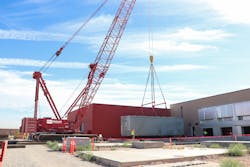How the Supply Chain Crisis Should Change Our Approach Moving Forward
Integrators
With the rise of modularization in our industry, integrators are playing a significant role in the supply chain and construction schedule. Currently, integrators are in a tough position. They have to take a project design spec and turn it into a prefabricated critical product ASAP. The lead time from design spec to production order is short and project based. So, how do they build a long-term raw material sourcing and an inventory plan? If the integrator has new designs project by project, they are essentially a project manufacturer that must order raw materials after release of a project order, which allows for very little inventory to integrate. This is a supply chain constraint that the project team can’t see.
With short lead times from project opportunity to contract award, that project win (for the integrator) can quickly eat up 100% of their manufacturing and assembly floor space. As many of you know, for our industries busiest integrators, floor space can be at a premium. Space and travel paths through the areas of inventory, fabrication, assembly, testing, and shipping is limited. On the flip side for these integrators, investing up in more floor space can be difficult when living project to project. Along with limited floor space, the integrator working through labor resource scaling when taking the project approach can also be a challenge.
So, how can we help integrators and OEMs with better demand planning over multiple years? Perhaps a program mindset over a project mindset. This may require deeper relationships and earlier commitments with integrators, but the payoff would be tremendous. With multiyear visibility for integrators, they can scale up their team, make better purchasing decisions, and ultimately better serve their customers and our industry. Without this level of visibility, there will always be supply chain constraints and bottlenecks at the integrators.
Skilled Trade Labor
Let me share a quick story that provides a great example of limited visibility for onsite labor, specifically for a crane and rigging partner. This example is from a different industry, however the mentality around communication with trade partners is easily transferable to the data center industry. Our team was contracted to offload, haul, and set a package boiler at a paper mill. The project was very complex with numerous space limitations when offloading and setting the large boiler, and the rigging specific details that we needed to plan our scope were imperative to the development of our plan. What I failed to respect in my communication with the boiler manufacturer’s project manager is how low a priority our very important rigging specific details were to him. The project was completed safely and at our post job meeting I made a comment to the project manager that it was tough at times to get critical pieces of information on the boiler’s design to confirm our rigging plan. His response was honest and enlightening. He mentioned the logistics, offloading, and setting (our scopes of work) totaled no more than 10% of his total project contract with the owner. So, during pre-job planning, he looked at communication with our company as not needing to take up any more than 10% of his planning hours. Our logistics, offloading, and setting scope was very small in the grand scheme of his entire project, and in return, of very small importance to him compared to the rest of the project. However, if we were unable to execute our scope of work on time, there would have been major project schedule delays, ultimately impacting the completion date. It was a good lesson for our company in understanding, respecting, and exploring how low visibility aspects of the supply chain can be managed and developed to build stronger collaborative project and program teams.
We come across these same challenges when developing rigging, transport and logistics plans for our data center partners. We know there is room for optimization and efficiencies to be gained from the initial plan used to develop the project budget. However, sometimes key design and layout information may not be available until right up to the time of onsite mobilization. In other cases, we have been brought into the project development early on, which has provided deeper visibility into the planning and supply chain. As a result, we have maximized our efficiency, improving the project schedule. With this deeper visibility, we’ve been able eliminate engineered rigging arrangement drawing changes, develop custom lifting equipment to reduce the height and weight of the below the hook rigging arrangements, size down our heavy lift crane (which reduces the onsite footprint and optimizes the mobilization), reduce onsite ground prep, optimize the equipment setting schedule, and reduce onsite delays and stand by time. All these items may sound small, but they add up to provide significant schedule and cost savings.
Increased visibility is a valuable lesson learned from the supply chain crisis. The key to increasing supply chain visibility across all parties requires deeper relationships, and earlier commitments, with industry partners. The earlier your partners are engaged in your plan, the better suited they will be to support your objectives. From a crane and rigging perspective, we’ve experienced both late engagement with limited visibility and early engagement with deep visibility, and we’ve found tremendous success for all parties with the latter approach. One of the key takeaways from the supply chain crisis we find ourselves in, is to increase visibility for all involved.
Bill Tierney is Senior Vice Preside at ProLift Rigging. ProLift Rigging helps data center owners and contractors build data centers faster and more efficiently through innovative solutions.


